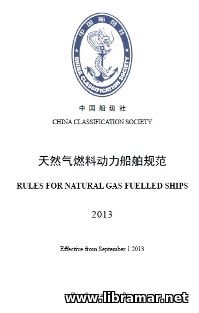 The Rules are considered applicable to the steel vessels having the gas fuel engines installed and also having a length of not less than twenty meters. They do not apply to the passenger vessels and carriers of the dangerous cargoes. Note that the natural gas fuelled vessels shall also comply with the requirements of the CCS Rules for the Classification of Steel Sea-Going Ships, as applicable.
In addition to that, due attention shall be paid to all relevant requirements of the Administration, if any. The vessels to which these Rules apply may be powered by either single- or dual fuel. The natural gas is commonly stored in liquid or gaseous form.
The content of the document is arranged in several chapters covering all important aspects including general provisions and associated documentations and plans, location on spaces on board ships and their separation, air locks and accesses, design of shipboard systems and piping arrangements, supply of the gas fuel, storage of the gaseous fuels - containment systems, portable tanks, storage of the fuel on the open deck and in the enclosed- and semi-enclosed spaces, bunkering, ventilation, fire safety arrangements, training and operation requirements, and many other issues.
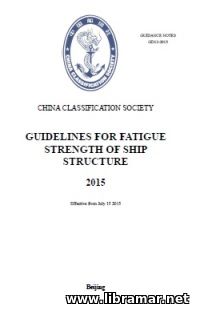 The Guidelines for the assessment of the fatigue strength of the ship structure developed and released by China Register. The authors of the document conducted a thorough research during which they mainly relied on the technical system of the current CCS Rules for the vessels engaged in domestic and international voyages, relevant fatigue assessment requirements, and absorbed the available international method and concept of the fatigue strength assessment.
These newly issued Guidelines feature the adoption of the load system having much more clear physical meaning and basing on the equivalent wave, adoption of the spot stress to the assessment of the fatigue strength, improving the rationality of the S-N curve selection and more exactly considering the mean stress correction. The document also adds new method of the assessment that can be applied to the membrane tank liquid gas carriers.
The content of the Guidelines is arranged in six chapters providing general information, addressing the design load and design analysis, as well as the final element - and simplified stress analysis, and finally the fatigue strength of pump tower. The appendix provides some additional information on hull structural details of three types of ships, namely oil tankers, containerships and bulk carriers.
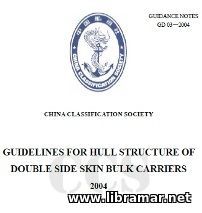 The Guidance Notes issued by the China Register to address the hull structure of bulk carriers featuring double side skin. The requirements contained in this document shall apply to the bulk carries mentioned above and having a length of ninety meters or more with the machinery space located aft, strength decks framed longitudinally and having double bottom.
The main purpose of application of the present Guidelines is to properly determine the structural arrangements as well as the scantlings of the structural members of the cargo hold spaces. The introductory chapter of the volume provides info n the class notations, vessel arrangement, documents and plans, structural details, fatigue assessment, direct strength calculations etc.
The main content of the Guidelines is arranged in the next ten chapters addressing the materials, protection, longitudinal strength including loading manual/instrument, hopper tanks including longitudinals and sloping plating, transverse members and both watertight and non-watertight bulkheads, description and technical features of the double side skin hull construction, topside tanks, watertight bulkheads and bottom structures, hatch cover scantlings, design loading conditions, etc. Typical structural details are provided in the appendix for reference.
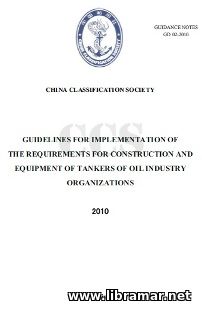 Have a look in the officially published China Register guidelines addressing the implementation of the requirements that are applicable to the construction/equipment of the tankers. The guidebook opens with introduction where purpose and application of the document are explained; in addition, it gives information about the standards that were used as a basis when preparing the Guidelines, describe the process of submission and further examination of the relevant documents and plans etc.
The chapter devoted to the construction and equipment of tankers deal with the materials used for the construction of tankers, towing arrangements and cargo handling equipment plus navigation in iced waters etc. Then a chapter comes devoted to the mooring equipment of tankers including design of the environmental conditions, winches, fairleads, bollards, butts, lines, SPM equipment and its arrangement.
The rest of the chapters are dealing with the pollution prevention, shipboard ballast and cargo systems, prevention of fires and explosions on board, lifting equipment, safety facilities and other important matters. Four appendices in the closing part of the volume provide some additional information.
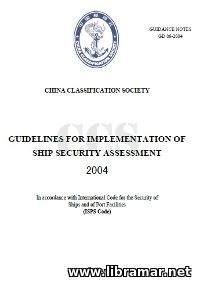 The China Register publication dealing with one of the important aspects of ship security, namely its proper assessment and providing all required guidance in this regard. The ship is considered secure when the ship herself and crew members, personnel, cargo and equipment on board, and all operations carried out are duly protected from any sort of illegal activity and terrorist attacks.
The main purpose of ISPS Code implementation was to establish, implement, maintain and continuously improve the ship security management system, enabling the shipping company and the vessel to control the risk and enhance the effect. Each vessel trading internationally will eventually encounter some risk of security threat and the extent of such risk will change in a manner reflecting the changes of the service environment.
And, effective security management system shall be able to respond to these changes of maritime security threat. The decision making based on the results of properly conducted risk assessment is considered one of the best ways to complete a security assessment and shall determine all security measures for the particular vessel. The risk assessment method shall be adopted in ship security management, as per the ISPS Code.
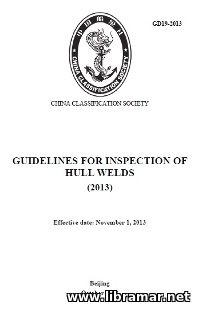 A very useful publication containing practical guidelines issued by China Register for the inspection performed on ship hull welding. Welding is considered an essential and very important link in the long chain of modern ship construction and repair. This document was prepared with the intention of the authors to ensure that the appropriate control of key technological factors that are involved throughout the whole hull welding process is taking place.
The volume constitutes a supplement to the CCS Rules for Materials and Welding, Part 3 where practical recommendations have been provided for the operations of all parties concerned with hull construction. The requirements contained in the document are recommendatory, of course except requirements same in the Rules mentioned above.
The guidelines shall apply to production of the welding consumables and performance of the welders qualification test, design, review and subsequent approval of the welding procedures, welding preparation and welding itself, post-weld non-destructive evaluation of weld seams and all other inspections related to the ship construction and repair. They mainly apply to steel and aluminum hulls complying with the relevant requirements of the Rules.
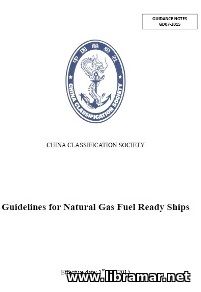 The publication released by China Register and providing guidance notes concerned with the natural gas fuel ready vessels. The requirements for control of the air pollution from vessels become more and more strict - subject matter is governed by the internationally recognized documents such as MARPOL convention, relevant codes and regulations governing these systems.
The present guidebook was prepared by CCS to supplement the CSS Rules with the intention to define the applicable technical requirements relating to the natural gas fuel ready systems and also to provide necessary guidance for the design of such vessels, their periodical surveys, construction and conversion projects. The main content has been arranged in four major chapters, first one being introductory and containing general provisions including definitions and scope of application.
The second chapter contains technical requirements commonly applicable to this type of systems. The third chapter of the paper is dealing with the plans and documents including general requirements, conversion plans, etc. The last chapter is devoted to the surveys and contains both general and special requirements.
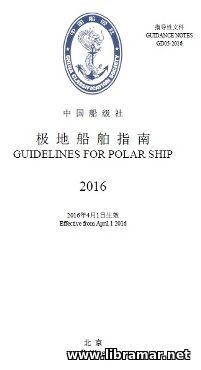 The polar region covers the Arctic and the Antarctic and is considered coldest area on the planet. It has remained silent for so many years as the ice and snow cover it all year round combined with the adverse whether conditions. Taking global warming into account, the sea ice in the above mentioned geographic region is melting faster and this is creating navigable open areas in summertime.
The present China Register guidelines have been prepared to provide industry with the professional guidance for design and provision of equipment of polar ships; it also addresses the operation, periodical surveys and certification of these ships. The document gives all required information to the designers and ship owners about the regulatory documentations relating to Arctic Passages.
The content is arranged in several chapters dealing with the survey and certification of polar ships, ship hull structures and provision equipment, stability of the ships including both intact and damage stability, shipboard machinery and electrical installation including main propulsion and steering, deck equipment and all auxiliary equipment, safety equipment and arrangements such as firefighting, lifesaving, navigational and communication equipment, and operational matters including limitations and operational capability of the ships, pollution prevention, risk management and training.
« 1 2 ... 7 8 9 10 11 ... 29 30 » |







